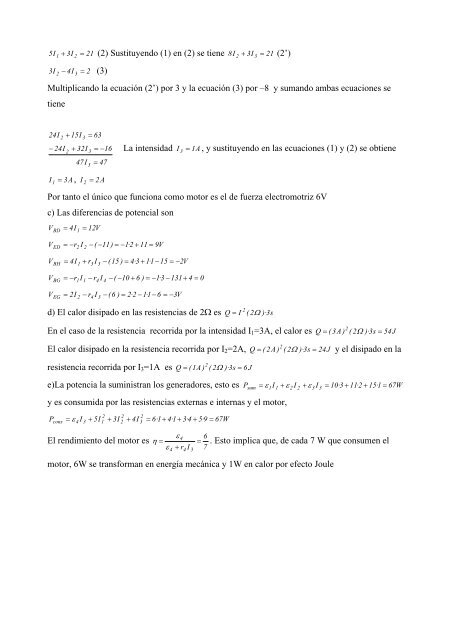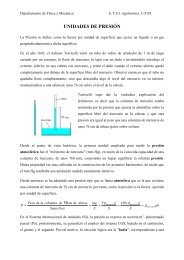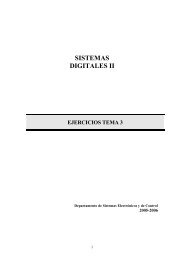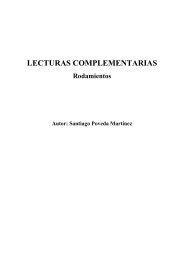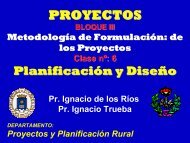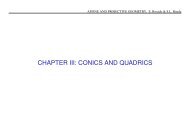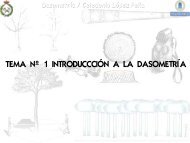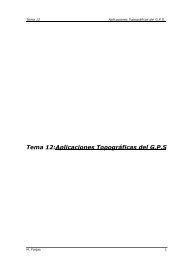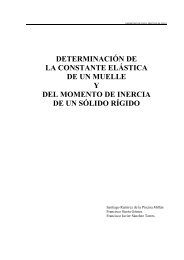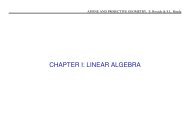En el circuito de la figura calcular a) Resistencia ... - OCW UPM
En el circuito de la figura calcular a) Resistencia ... - OCW UPM
En el circuito de la figura calcular a) Resistencia ... - OCW UPM
You also want an ePaper? Increase the reach of your titles
YUMPU automatically turns print PDFs into web optimized ePapers that Google loves.
5I<br />
1 + 3I 2 = 21 (2) Sustituyendo (1) en (2) se tiene 8I<br />
2 3I 3 = 21<br />
3I<br />
2 − 4I 3 = 2 (3)<br />
+ (2’)<br />
Multiplicando <strong>la</strong> ecuación (2’) por 3 y <strong>la</strong> ecuación (3) por –8 y sumando ambas ecuaciones se<br />
tiene<br />
24I<br />
2<br />
− 24I<br />
+ 15I<br />
2<br />
3<br />
+ 32I<br />
47I<br />
= 63<br />
3<br />
3<br />
= −16<br />
= 47<br />
La intensidad<br />
I 3 = 1A<br />
, y sustituyendo en <strong>la</strong>s ecuaciones (1) y (2) se obtiene<br />
I 1 = 3A , I 2 = 2A<br />
Por tanto <strong>el</strong> único que funciona como motor es <strong>el</strong> <strong>de</strong> fuerza <strong>el</strong>ectromotriz 6V<br />
c) Las diferencias <strong>de</strong> potencial son<br />
V = 4I 1<br />
BD =<br />
V 2<br />
12V<br />
ED = −r2<br />
I −(<br />
−11)<br />
= −1·2<br />
+ 11 = 9V<br />
VBH<br />
= 4I 1 + r3<br />
I 3<br />
V 4<br />
−(15 ) = 4·3 + 1·1 − 15 = −2V<br />
BG = −r1<br />
I 1 − r4<br />
I −(<br />
−10<br />
+ 6 ) = −1·3<br />
− 131+<br />
4 = 0<br />
VEG<br />
= 2I 2 − r4<br />
I 3<br />
−(6 ) = 2·2 − 1·1 − 6 = −3V<br />
2<br />
d) El calor disipado en <strong>la</strong>s resistencias <strong>de</strong> 2Ω es Q = I ( 2Ω<br />
)·3s<br />
<strong>En</strong> <strong>el</strong> caso <strong>de</strong> <strong>la</strong> resistencia recorrida por <strong>la</strong> intensidad I 1 =3A, <strong>el</strong> calor es<br />
2<br />
Q = ( 3A ) ( 2Ω<br />
)·3s = 54J<br />
El calor disipado en <strong>la</strong> resistencia recorrida por I 2 =2A,<br />
2<br />
Q = ( 2A ) ( 2Ω )·3s = 24J<br />
y <strong>el</strong> disipado en <strong>la</strong><br />
resistencia recorrida por I 3 =1A es<br />
2<br />
Q = ( 1A ) ( 2Ω<br />
)·3s = 6 J<br />
e)La potencia <strong>la</strong> suministran los generadores, esto es<br />
sum = ε 1I<br />
1 + ε 2 I 2 + ε 3 I = 10·3 + 11·2 + 15·1 =<br />
P 3<br />
y es consumida por <strong>la</strong>s resistencias externas e internas y <strong>el</strong> motor,<br />
2<br />
2<br />
Pcons = ε 4 I 3 + 5I 1 + 3I 2 + 4I 3 = 6·1 + 4·1 + 3·4 + 5·9 = 67W<br />
ε 4<br />
El rendimiento d<strong>el</strong> motor es η = ε<br />
2<br />
4<br />
=<br />
+ r4<br />
I 3<br />
6<br />
7<br />
. Esto implica que, <strong>de</strong> cada 7 W que consumen <strong>el</strong><br />
motor, 6W se transforman en energía mecánica y 1W en calor por efecto Joule<br />
67W


